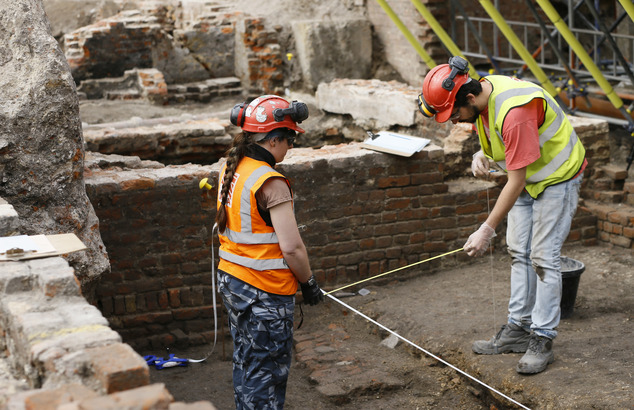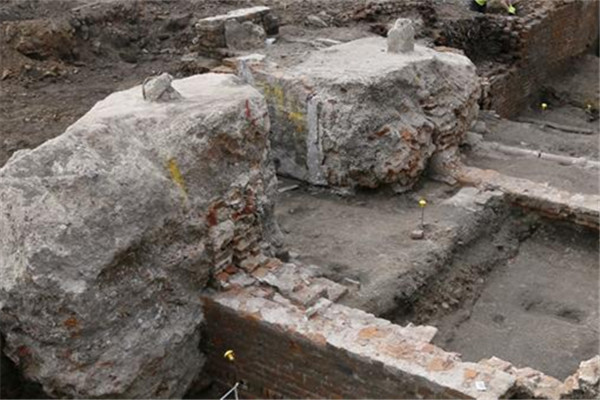The very stage on which the great Shakespeare stood has been unearthed! But it's not the "wooden O" described in the prologue of 'Henry the Fifth'. Instead, much to the surprise of scholars, this great history play was first performed in a rectangular space. This is among a series of fascinating discoveries in east London at the excavation site of "The Curtain" theatre.
Here, at a bustling London building site, archaeologists are making new discoveries about Shakespeare and his age.
The Curtain's remains were first uncovered here in 2011 on a site earmarked for development, but excavations began in earnest only last month.

Archaeologists uncover surprises at Shakespeare's theatre.
Defying expectations, this theatre does not conform to the shape of most Elizabethan playhouses.
"What we didn't know before we started this detailed excavation is the shape of this building. Now we know it's rectangular, which is really interesting, because for a long time it was thought it was going to be polygonal like, say, The Globe on Bankside," said Heather Knight, senior archaeologist, museum of London Archaeology.
The discovery has caused experts to rethink their ideas about Tudor playhouses. It's now suspected the Curtain - unlike the more famous Globe and Rose theatres - was not built from scratch, but converted from an existing building.
"I don't think the players would have found it strange, because they were quite used to performing in inyards which were rectangular..." Heather Knight said.
Confusion arises in large measure because the best-known fact about the Curtain is that Shakespeare's "Henry V" was first staged here. Yet the opening Chorus of "Henry V" refers to "this wooden O".
Why, then, is the Curtain Theatre not O-shaped?!

Digging will continue until the end of June, and visitors can book tours of the excavations as part of events to mark this year's 400th anniversary of Shakespeare's death.
The discrepancy is best explained by the theory that prologues were often a later addition to plays of the time.
The dig has uncovered the outline of a rectangular venue around 30 metres by 22 metres, with a capacity of around a thousand people.
Workers have uncovered sections of the theatre's gravel yard where stood the "groundlings", who had bought cheap tickets. Among their ranks, we may suppose, were those youths mentioned by Shakespeare "who thunder at a playhouse and fight for bitten apples".
Archaeologists say the Curtain site has probably the best preserved remains of any of the playhouses they've looked at.
Also, among the various artefacts uncovered, is this 16th-century bird whistle. Could this have been "the lark, the herald of the morn" described by Romeo upon waking up beside Juliet? We'd like to think so!
"It's a sort of small ceramic vessel. You would have filled it with water and blown into it to create the sound of birdsong. And when you think of say 'Romeo and Juliet', there's quite a lot of birds mentioned in that, there's nightingales and larks. So within this context, it's possible that this Elizabethan novelty was actually used as a special effect," Heather Knight said.
But of the many connections Shakespeare has to this venue, perhaps the most fascinating is that he acted here too, as Shakespeare expert Julian Bowsher explains.
"We know that Shakespeare actually acted here. He acted - not in one of his own plays, he might have done - but what we do know is that he acted in Ben Jonson's new play called 'Every Man in his Humour', which was premiered here, and Shakespeare is on the cast list. So we have definite proof that Shakespeare was working on that stage, which is quite exciting," said Julian Bowsher, Shakespearean expert.
Digging will continue until the end of June, and visitors can book tours of the excavations as part of events to mark this year's 400th anniversary of Shakespeare's death.















